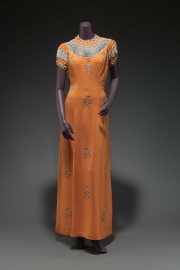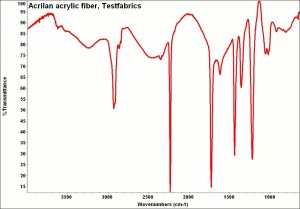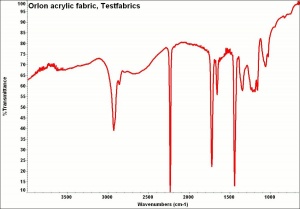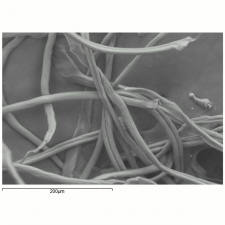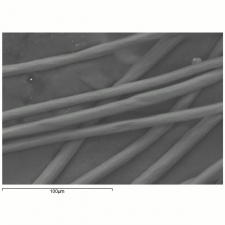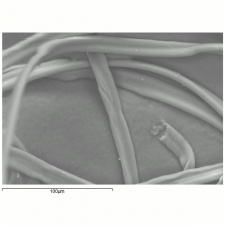Difference between revisions of "Acrylic fiber"
(username removed) |
(username removed) |
||
| Line 2: | Line 2: | ||
== Description == | == Description == | ||
| − | A manufactured fiber in which the fiber-forming substance is any long chain synthetic polymer composed of at least 85% by weight of [http://cameo.mfa.org/materials/fullrecord.asp?name=acrylonitrile acrylonitrile] units (Federal Trade Commission definition). Acrylic fibers were first commercially manufactured in 1950 by DuPont as the product | + | A manufactured fiber in which the fiber-forming substance is any long chain synthetic polymer composed of at least 85% by weight of [http://cameo.mfa.org/materials/fullrecord.asp?name=acrylonitrile acrylonitrile] units (Federal Trade Commission definition). Acrylic fibers were first commercially manufactured in 1950 by DuPont as the product Orlon®. The [http://cameo.mfa.org/materials/fullrecord.asp?name=acrylic%20resin acrylic resin] is dissolved in a solvent, then extruded through spinnerets to produce long, continuous filaments. The smooth, [http://cameo.mfa.org/materials/fullrecord.asp?name=thermoplastic thermoplastic] fibers are resistant to wrinkles, chemicals, [http://cameo.mfa.org/materials/fullrecord.asp?name=ultraviolet%20radiation UV light], [http://cameo.mfa.org/materials/fullrecord.asp?name=weathering weathering], insects, [http://cameo.mfa.org/materials/fullrecord.asp?name=mildew mildew], and moisture. They produce fabrics that are non-allergenic, lightweight, soft, durable and fast drying. They are, however, susceptible to heat and will melt or burn. Acrylic fibers are used for carpets, blankets, drapes, outdoor products (awnings, [http://cameo.mfa.org/materials/fullrecord.asp?name=geotextile geotextiles], etc) and apparel such as sweaters, coats, linings, hosiery, dresses, and shirts. |
[[File:Acrylic 200x PP.POL.jpg|thumb|Acrylic fibers]] | [[File:Acrylic 200x PP.POL.jpg|thumb|Acrylic fibers]] | ||
== Synonyms and Related Terms == | == Synonyms and Related Terms == | ||
| − | acrylic fibre (Br.); fibra | + | acrylic fibre (Br.); fibra acrílica (Esp.); fibre acrylique (Fr.); acrylaat vezel (Ned); polyacrylonitrile; Orlon® [DuPont]; Creslan® [Sterling]; Zefran® [Badische]; Acrilan® [Solutia]; Dynel® [Union Carbide]; Crylor; Courtelle®; Dralon®; |
| − | [[[SliderGallery rightalign|acrilan300m.jpg~SEM|creslan500m.jpg~SEM|orlon500am.jpg~SEM]]] | + | [[[SliderGallery rightalign|AcrilanTestfabrics.jpg~FTIR|CreslanTestfabrics.jpg~FTIR|OrlonTestfabrics.jpg~FTIR|acrilan300m.jpg~SEM|creslan500m.jpg~SEM|orlon500am.jpg~SEM]]] |
== Other Properties == | == Other Properties == | ||
| Line 34: | Line 34: | ||
== Additional Information == | == Additional Information == | ||
| − | M. Joseph, ''Introductory Textile Science'', Holt Reinhold & Winston, Fort Worth, 1986. G.Cook, ''Handbook of Textile Fibres:II. Man-made Fibres'', 5th edition, Merrow Publishing Co., Durham, England, 1984. | + | ° M. Joseph, ''Introductory Textile Science'', Holt Reinhold & Winston, Fort Worth, 1986.° G.Cook, ''Handbook of Textile Fibres:II. Man-made Fibres'', 5th edition, Merrow Publishing Co., Durham, England, 1984. |
== Comparisons == | == Comparisons == | ||
| Line 42: | Line 42: | ||
[[media:download_file_47.pdf|Fiber Burn Tests]] | [[media:download_file_47.pdf|Fiber Burn Tests]] | ||
| − | |||
| − | |||
| − | |||
| − | |||
| − | |||
| − | |||
| − | |||
| − | |||
| − | |||
== Authority == | == Authority == | ||
| − | * | + | * Hoechst Celanese Corporation, ''Dictionary of Fiber & Textile Technology'' (older version called Man-made Fiber and Textile Dictionary, 1965), Hoechst Celanese Corporation, Charlotte NC, 1990 |
| − | * | + | * Rosalie Rosso King, ''Textile Identification, Conservation, and Preservation'', Noyes Publications, Park Ridge, NJ, 1985 |
| − | * | + | * Marjory L. Joseph, ''Introductory Textile Science'', Holt, Rinehart and Winston, Fort Worth, TX, 1986 |
| − | * | + | * J.Gordon Cook, ''Handbook of Textile Fibres:I Natural Fibres'', Merrow Publishing Co. , Durham, England, 1984 |
| − | * | + | * Meredith Montague, contributed information, 1998 |
| − | * | + | * Website address 1 Comment: Fabrics.net : [http://www.fabrics.net Link] |
[[Category:Materials database]] | [[Category:Materials database]] | ||
Revision as of 07:35, 24 July 2013
Description
A manufactured fiber in which the fiber-forming substance is any long chain synthetic polymer composed of at least 85% by weight of acrylonitrile units (Federal Trade Commission definition). Acrylic fibers were first commercially manufactured in 1950 by DuPont as the product Orlon®. The acrylic resin is dissolved in a solvent, then extruded through spinnerets to produce long, continuous filaments. The smooth, thermoplastic fibers are resistant to wrinkles, chemicals, UV light, weathering, insects, mildew, and moisture. They produce fabrics that are non-allergenic, lightweight, soft, durable and fast drying. They are, however, susceptible to heat and will melt or burn. Acrylic fibers are used for carpets, blankets, drapes, outdoor products (awnings, geotextiles, etc) and apparel such as sweaters, coats, linings, hosiery, dresses, and shirts.
Synonyms and Related Terms
acrylic fibre (Br.); fibra acrílica (Esp.); fibre acrylique (Fr.); acrylaat vezel (Ned); polyacrylonitrile; Orlon® [DuPont]; Creslan® [Sterling]; Zefran® [Badische]; Acrilan® [Solutia]; Dynel® [Union Carbide]; Crylor; Courtelle®; Dralon®;
Other Properties
Insoluble in most common organic solvents. Resistant to weak acids. Burns readily with smoky flame and acid smell. The ash is hard.
Moisture regain = 1.0-3.0% Elongation = 20-55% (dry) Tenacity = 2.0-3.6 g/denier (dry)
Cross section = variable (dogbone, round, bean shaped or lobed)
| Melting Point | 215-255 (soften) |
|---|---|
| Density | 1.16-1.18 |
Hazards and Safety
Combustible. Accumulates static charge.
Additional Information
° M. Joseph, Introductory Textile Science, Holt Reinhold & Winston, Fort Worth, 1986.° G.Cook, Handbook of Textile Fibres:II. Man-made Fibres, 5th edition, Merrow Publishing Co., Durham, England, 1984.
Comparisons
Properties of Synthetic Fibers
Authority
- Hoechst Celanese Corporation, Dictionary of Fiber & Textile Technology (older version called Man-made Fiber and Textile Dictionary, 1965), Hoechst Celanese Corporation, Charlotte NC, 1990
- Rosalie Rosso King, Textile Identification, Conservation, and Preservation, Noyes Publications, Park Ridge, NJ, 1985
- Marjory L. Joseph, Introductory Textile Science, Holt, Rinehart and Winston, Fort Worth, TX, 1986
- J.Gordon Cook, Handbook of Textile Fibres:I Natural Fibres, Merrow Publishing Co. , Durham, England, 1984
- Meredith Montague, contributed information, 1998
- Website address 1 Comment: Fabrics.net : Link
